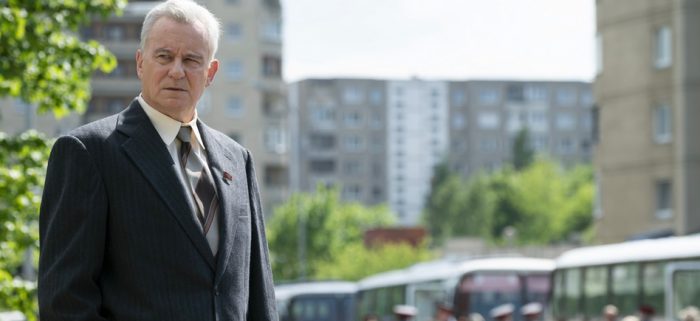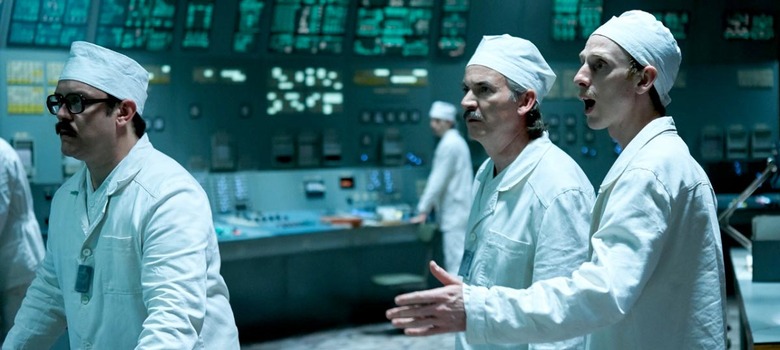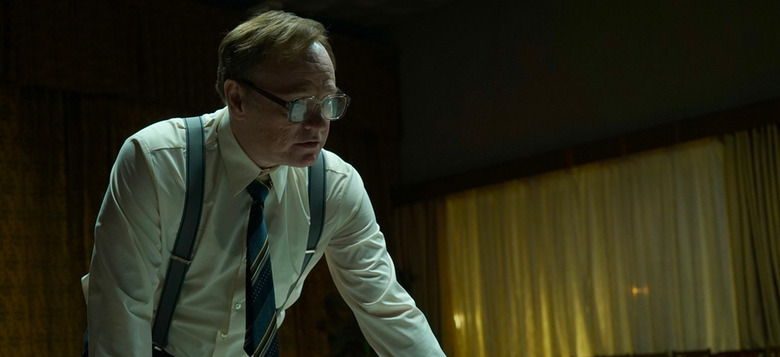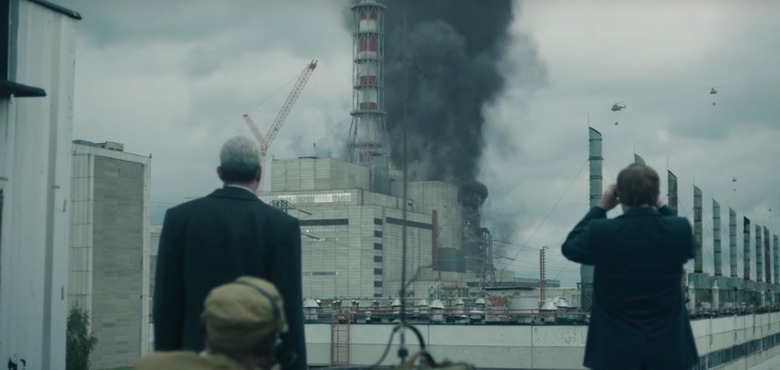Why HBO's 'Chernobyl' Is 2019's Most Vital, Terrifying And Relevant Horror Story
A week before TV viewers witnessed a dragon burning thousands of people to death in Game of Thrones, and a couple of weeks before Godzilla fought Ghidora and Mothra stole our hearts in Godzilla: King of the Monsters, HBO released not only the best depiction of the dangers of radiation, but also the most terrifying TV series in years. The Haunting of Hill House made us cry and scream, but Chernobyl will haunt our collective nightmares for weeks to come.If you are not old enough to remember the Chernobyl nuclear disaster as it happened on April 26, 1986, you probably learned about it via the lens of popular culture. In 2019 most people know what Chernobyl is, yet not everyone knows what exactly happened of how it affected the people living close to Reactor Number 4 at the V.I. Lenin Nuclear Power Station. It is in this space of uncertainty that creator, writer and showrunner Craig Mazin thrives.
Horror through foreknowledge
(Fair warning: spoilers for Chernobyl ahead.)
The first of the five hour-long episodes of Chernobyl begins not with the moments leading up to the explosion, or the explosion itself, but with the suicide of Soviet nuclear physicist Valery Legasov (Jared Harris) and a secret memoir that considers the cost of lies. Then we jump back in time to the moments following the explosion of the nuclear reactor, seen through the apartment of Pripyat residents Lyudmilla Ignatenko (Jessie Buckley) and her husband Vasily (Adam Nagaitis), a firefighter who becomes one of the first responders to the initial reaction.We don't see how the reactor exploded or what made it happen, instead we see the harrowing effects it had on those who worked endlessly to prevent the disaster from getting worse. The show keeps the panic intimate, showing us but a handful of characters at a time, the ones stuck at the understaffed nuclear plant and tasked with ascertaining just what happened to the core by a boss who refuses to believe it exploded. The chaos resulting from management not acknowledging the disaster while workers say the air tastes like metal (a very bad sign) and Lyudmilla at a nearby hospital seeing an impossible beam of blue light coming out of the plant feels like a scene out of a Godzilla or zombie movie, as the refusal to face what is clearly happening means many people will die.Inside the power plant we meet a man named Yuvchenko (Douggie McMeekin) who, after holding open the door leading to the nuclear reactor for a few minutes with his hip, sees his flesh burned by radiation. We see the two workers for whom Yuvchenko opened the door look into the wide-open reactor for a couple of seconds and still come out with half their faces scorched from the radiation. Outside the plant we see the firefighters battle the blaze without any kind of protection, because they do not know of the cause of their being there. One of them, Misha (Sam Strike) unknowingly picks up a piece of graphite for a few seconds, and later is seen with his hand burned beyond recognition. Even Vasily, who doesn't touch anything radioactive but gets close to the open reactor, ends the episode vomiting and crying out in pain until he passes out. These gruesome images to start a miniseries with, but they ultimately make final episode of the series all the more horrifying. It isn't until the last hour of Chernobyl that Legasov finally explains what happened in the hours and minutes leading up to the worst nuclear disaster in history. By then we recognize the faces of the workers of the nuclear plant, we remember their names and most importantly, we remember the horrible fate that awaits them because we already saw all that. Outside the plant, we see the people of Pripyat going on about their day, only by now we know they will be forcedly evacuated from their homes, never to return again, and that many of them will die horribly for not being evacuated soon enough.
Horror through exposition
Where other shows use exposition dumps to convey the information they couldn't fit elsewhere, Chernobyl keeps the important information close to the chest. When we finally get some explanations, even the description of how a nuclear power plant works becomes an exercise in horror storytelling that will give you chills. In the case of the scene in which Legasov uses blue and red placards in order to illustrate the power inside the nuclear core going up or down, it becomes all the more tense because we have seen just how far the government went to downplay the dangers of the reactor exploding. By the time the blue placards disappear, and we only see the red placards representing the power increasing beyond anyone's imagination, we don't need to see the explosion to feel the tension, because we've already seen its effects on the people of Pripyat.It is the use of lies and truth that the series thrives as it allows for the delivery of truthful facts (or as close as a narrative TV show can get to it) in exposition dumps to feel like a plot twist. Throughout Chernobyl, we see the repeated attempts by the Soviet government to cover up the incident and make it seem like nothing bad was happening, from the plant's supervisor all the way up to Mikhail Gorbachev (David Dencik). After hearing repeatedly that the radiation levels were harmless and not a cause for worry, but before we find out how everything went down and how serious it is, we get a scene in which Legasov tells a room full of party politicians – including Gorbachev – that each atom of uranium-235 is like a bullet, and Chernobyl has over a billion trillion bullets. The whole scene should be an information dump, but for us, it is something more: a damn tense and scary scene because we have seen the power plant workers and firefighters starting to show symptoms of something truly serious.
Horror through sacrifice
Because of the enormity of the nuclear calamity, the Soviet government had to rely on thousands upon thousands of people to clear up the area and ensure that the radiation wouldn't spread to the rest of Europe. This is where Chernobyl shows both the heroism of the volunteers that fought this crisis, and the horrors they faced. If you haven't yet, do go through Slava Malamud's Twitter threads giving a Russian perspective on each episode of the miniseries. When writing on episode four, "The Happiness of All Mankind", Malamud comments on Russian collectivism, and how it values the whole of the nation way more than individual lives. This is an ideology that permeates through the miniseries, as Legasov and Central Committee member Boris Shcherbina (Stellan Skarsgård) are forced to ask volunteer after volunteer to give up their life in gruesome ways in order to stop the catastrophe.Consider the closing moments of the second episode of Chernobyl, "Please Remain Calm," in which three brave men, mechanical engineer Alexei Ananenko, senior engineer Valeri Bespalov and shift supervisor Boris Baranov volunteer to dive into radio-contaminated water beneath the Chernobyl Nuclear Power Plant. Under the exploded and exposed reactor was a huge pool of water that, when in touch with the open core, would allegedly create a second steam explosion that would destroy the other three reactors and leave Europe uninhabitable. These men, outfitted in protective suits and gas masks, venture into the darkness of the building's basements in search of the valves that would drain the contaminated waters.Dubbed by history as "The Suicide Squad", Chernobyl shows the dread and claustrophobia these men felt, who walked half-submerged in contaminated water to find what is pretty much a needle in a haystack. Johan Renck's exquisite direction turns these short scenes into a fully fledged horror movie, as the only light we see is the dim light of a flashlight that guides the brave men through a maze of valves and pipes, and the only sound we hear is the men's laboring breathing and the radiation detector's constant ticking. It is like a scene taken straight from Alien, only with an invisible monster that kills you more slowly and painfully. Not only is that a horrifying scene in and of itself, but the moments leading up to it where Legasov has to explain to a group of engineers that they'll die horrible and painful deaths if they accept the assignment is equally as haunting.When we finally check back with the Vasily, the other firefighters, and the engineers who worked in the control room the night of the explosion, we see their hair gone, including their eyebrows. The skin on most of them covered in discolored patches of red, green and even blue tones. When Lyudmilla finally gets to see her husband, she barely recognizes him. It's a marvel of make-up and prosthetics effects, as we see the flesh on Vasily looking almost translucid before turning black and finally liquefying due to the massive radiation. Their sacrifice complete, their deaths looking like straight out of a body horror movie. But it's real. Chernobyl excels at injecting terror into the most benign of things, turning the sight of children playing outside into an ominous warning of what lies beneath, or the swaying of tree branches looking like a better, scarier, more real version of The Happening. The more men we see walking into what will later be known as the Exclusion Zone, the area surrounding the power plant, the more dread we feel. "If not us, then who?" seems to be a question asked a lot in the miniseries, as we see several of the hundreds of thousands of volunteers who worked in the Exclusion Zone to prevent the disaster from expanding. Among them were a group of miners tasked with digging a relief tunnel to prevent a bigger catastrophe, who work in temperatures above 120 degrees Fahrenheit without any type of radiation shielding.Those miners, among other workers and volunteers, became known as "liquidators", which included a squadron responsible for finding and killing all abandoned household pets in the Exclusion Zone because they also were contaminated, a sequence I found so upsetting I can't even dwell on it here.Chernobyl excels at portraying not only the physical and body horror that these men and women experienced, but also the psychological horror inflicted on them. In one standout scene that's guaranteed to make your blood race, we follow a team of liquidators tasking with removing as much heavily radioactive graphite as possible from the roof of the plant. They must do this within a 90-second window before the radiation makes them collapse. We see wave after wave being sent out, scrambling to do their jobs knowing that the air itself is quickly killing them. There is no need for a literal, visible monster or a horde of zombies, because we have seen what happens when the mission fails, and they get overrun by the radiation.Before the miniseries, the Exclusion Zone had become a fertile ground for horror movies and videogames like Chernobyl Diaries and S.T.A.L.K.E.R, but in the end, none of them came close to replicating the excruciating horror that HBO and Sky UK's Chernobyl depicts. Cellular-killing radiation and the lies that allowed it to spread are terrifying enough, and deadly enough, to haunt our dreams and make sure nothing like this ever happens again. As far as horror TV series go, Chernobyl is as real as it gets.
Chernobyl excels at injecting terror into the most benign of things, turning the sight of children playing outside into an ominous warning of what lies beneath, or the swaying of tree branches looking like a better, scarier, more real version of The Happening. The more men we see walking into what will later be known as the Exclusion Zone, the area surrounding the power plant, the more dread we feel. "If not us, then who?" seems to be a question asked a lot in the miniseries, as we see several of the hundreds of thousands of volunteers who worked in the Exclusion Zone to prevent the disaster from expanding. Among them were a group of miners tasked with digging a relief tunnel to prevent a bigger catastrophe, who work in temperatures above 120 degrees Fahrenheit without any type of radiation shielding.Those miners, among other workers and volunteers, became known as "liquidators", which included a squadron responsible for finding and killing all abandoned household pets in the Exclusion Zone because they also were contaminated, a sequence I found so upsetting I can't even dwell on it here.Chernobyl excels at portraying not only the physical and body horror that these men and women experienced, but also the psychological horror inflicted on them. In one standout scene that's guaranteed to make your blood race, we follow a team of liquidators tasking with removing as much heavily radioactive graphite as possible from the roof of the plant. They must do this within a 90-second window before the radiation makes them collapse. We see wave after wave being sent out, scrambling to do their jobs knowing that the air itself is quickly killing them. There is no need for a literal, visible monster or a horde of zombies, because we have seen what happens when the mission fails, and they get overrun by the radiation.Before the miniseries, the Exclusion Zone had become a fertile ground for horror movies and videogames like Chernobyl Diaries and S.T.A.L.K.E.R, but in the end, none of them came close to replicating the excruciating horror that HBO and Sky UK's Chernobyl depicts. Cellular-killing radiation and the lies that allowed it to spread are terrifying enough, and deadly enough, to haunt our dreams and make sure nothing like this ever happens again. As far as horror TV series go, Chernobyl is as real as it gets.



